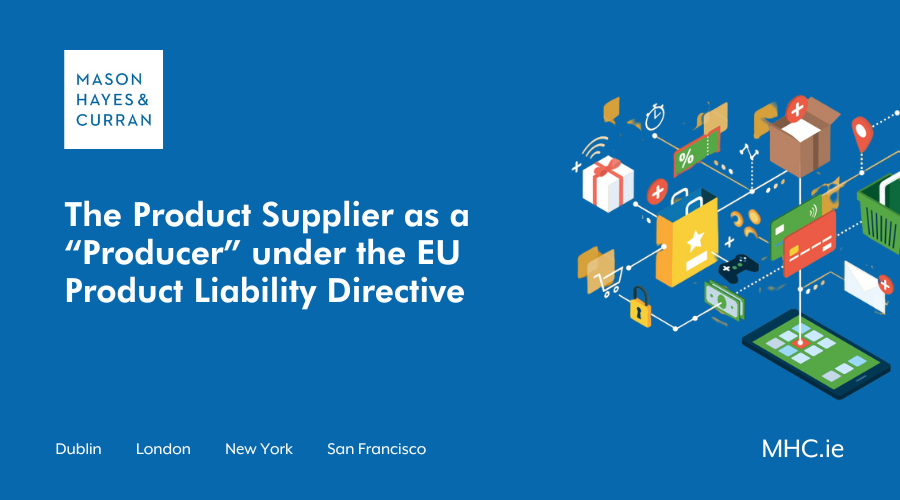The Product Supplier as a “Producer” under the EU Product Liability Directive
Clarifications from the CJEU

The Court of Justice of the European Union has ruled that product suppliers can be held liable as "producers" under the EU Product Liability Directive, if their name or trademark closely resembles that of the manufacturer. Product suppliers now may face greater liability for product liability claims. Our Products team explores the decision.
What you need to know
- The Court of Justice of the European Union (CJEU) ruled that suppliers can be considered "producers" under the EU Product Liability Directive (PLD) if their name or branding closely resembles that of the manufacturer.
- The ruling establishes that a supplier can be liable if their name or trademark appears on the product, regardless of whether they actively placed it there.
- The decision remains relevant as the revised PLD retains similar wording, extending its implications beyond tangible products to software and digital products.
Introduction
The CJEU has delivered an important decision interpreting the definition of "producer" under the EU Product Liability Directive, which increases the potential liability exposure for product suppliers as part of product liability claims.
The case: Ford Italia
A consumer, ZP, purchased a Ford vehicle from Stracciari, an Italian Ford dealer. The vehicle was produced by Ford WAG, a German entity, and supplied to Stracciari by Ford Italia, an Italian entity which distributes Ford WAG’s vehicles in Italy. After the vehicle’s airbags failed during an accident, ZP brought an action against both Stracciari and Ford Italia, seeking compensation for injuries caused by the defective airbag. Ford Italia contended that it was merely a supplier and therefore should not be held liable as a “producer” under the PLD. The case eventually reached the Italian Supreme Court of Cassation, who sought clarification from the CJEU on the scope of the term "producer" under Article 3(1) of the PLD.
The main question before the CJEU was whether a supplier or distributor, like Ford Italia, could be considered a "producer" even if it had not physically placed its branding on the product, but where the supplier’s name closely resembled the name or trademark of the manufacturer.
The decision
The definition of “producer” in the PLD includes not only the manufacturer of a physical product, but also anyone who presents themselves as a producer by placing their name, trademark, or other distinguishing feature on the product. The CJEU held that this definition does not require any active steps on the part of supplier, meaning that a supplier can be considered a "producer" under Article 3(1) of the Directive if:
- The supplier’s name, or a distinctive element of it, matches or resembles the manufacturer’s name or trademark, and
- That name or trademark appears on the product.
In such circumstances, the supplier effectively uses the similarity between its own name and the name on the product to bolster its credibility to consumers and give the impression that the supplier is responsible for the product. The key consideration, therefore, is not who physically placed the name on the product, but rather the impression that the presence of the name on the product creates among consumers. The CJEU emphasised that the PLD aims to protect consumers, and that to decide otherwise could enable suppliers to insulate themselves from liability.
The Revised Product Liability Directive
The EU adopted a revised Product Liability Directive (the revised PLD) in late 2024. Although the Ford Italia case regards the definition of “producer” under the previous version of the PLD, the decision remains important for several reasons:
- Member States have until December 2026 to transpose the revised PLD into their national legislation. However, this decision remains important for cases brought under national legislation that transposed the PLD which remains in force until then.
- The wording of the relevant provision of the PLD that was interpreted in the Ford Italia case has been replicated in the Revised PLD, with Article 4 (10) of the Revised PLD defining the ‘manufacturer’ of a product as anyone who “has a product designed or manufactured, or who, by putting their name, trademark, or other distinguishing features on that product, presents themselves as its manufacturer.” This decision may therefore retain precedential value when interpreting the revised PLD. Given that the revised PLD has been updated to adopt terms and concepts used in EU product safety legislation (such as the legal ‘manufacturer’ of a product, as opposed to ‘producer’), this decision may also be applied in the context of interpreting EU product safety legislation as well.
- The scope of the Revised PLD includes software within its scope. The Ford Italia decision could therefore have important implications for companies that serve as intermediaries or suppliers of software who share similar branding and/or company names or trademarks to the underlying software developer.
Conclusion
The CJEU’s decision in Ford Italia extends the scope of liability for defective products to include some suppliers and distributors. Entities involved in the supply and distribution of products should be aware of this new risk and should evaluate their naming and branding practices accordingly.
For more information and expert advice on the scope of this decision and its likely impact on your business operations, contact a member of our Products team.
The content of this article is provided for information purposes only and does not constitute legal or other advice
Share this:





